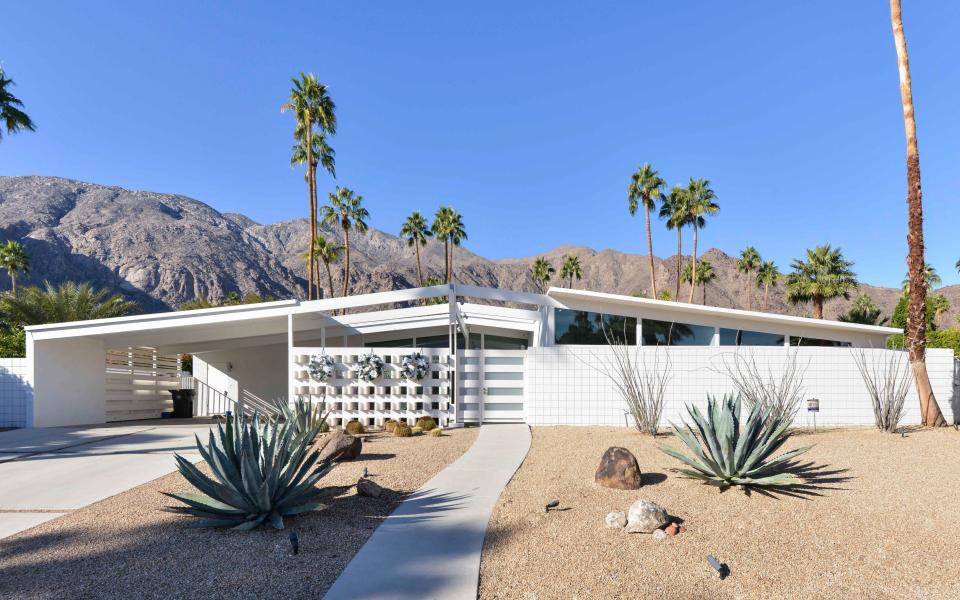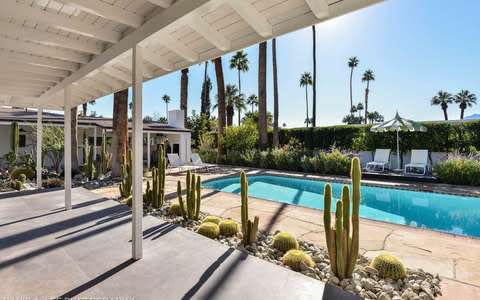Keep off the grass! How the modernist gardens of Palm Springs are embracing arid plants

I was mingling, awkwardly, at a newly renovated iconic hotel in Palm Springs when I overheard one of the city’s officials comment on the sense of history that beats through the place. “Some people, they want to keep this city encased in Ceran Wrap”. “But we’ve got to move with the times, sometimes”.
While many American cities are fond of tearing down the past in order to build shiny new statements of the future, Palm Springs, in the Coachella Valley of California, bucks that trend. It’s a development that only really gained infrastructure in the Victorian times, but experienced a massive building boom a century later.
Now, the one-storey homes (for they are far too stylish to be called bungalows) that sprawl beneath the San Bernadino mountains have made it a haven for fans of mid-century modern architecture. And those lucky enough to live in them face a quandary: how to maintain the lush, often lawn-led landscaping their beloved retro homes were built in a drought-threatened desert?
“A lot of people have been converting their front lawns to other more appropriate landscapes,” says local garden designer Paul Ortega, who is also involved in the running of the city’s Modernism Week. He’s giving me an impromptu tour around Indian Canyons, a neighbourhood in Palm Springs that illustrates well how the city is changing. Fifteen years ago, this acted as a kind of time warp – “It was really down-and-out,” explains Ortega, “the people who had moved in during the Sixties were like 80, and hadn’t left”.

An influx of “mostly gay men, mostly from San Francisco” saw the area as an opportunity for prime real estate development. In the past two decades, these lawn-covered gardens have transformed into clever, design-led landscaping that uses black bark, gravel and displays of arid planting as owners realise the sheer impracticality of trying to keep a velvet-soft lawn in the middle of the desert.
Palm Springs’ devotion to turf has curious origins – and, in part, the Brits are to blame. Until the First World War, rich Americans would holiday in Europe. But conflict pushed them to the warm climes of California. Palm Springs may have been in the desert, but its seasonal residents still aspired to European and East Coast-style landscaping: grass and big, thirsty annual blooms that were replaced ahead of their owners’ return. The continental shadow lingered well into the Sixties – when these cute, pastel-coloured houses were decorated with begonias and roses, much like in middle England at the time – and beyond. The gardeners here (many come with the house) sow two different grass seeds a year, one to put up with the summer’s punishing heats and then another to compensate come the cooler winter months.

The drought that ravaged California between 2011 and 2017, and took 102 million trees across the state with it, caused people to reconsider. “There was a real spate of people wanting to make that change from having a big front lawn,” Ortega explains. “Nobody uses it anyway, they’re using a back lawn - that’s where the grandkids play or where the dog goes out – and they don’t need the front.” Especially with so many of Palm Springs’ retro-future homes having a car park integrated into their homes: “They drive into their garage, they walk through the door, they enter the house, they don’t even see the lawn.”
The result is that the city now boasts a wide display of interesting domestic arid landscaping. While Ortega is one of local garden designers here who champion the use of desert-appropriate plants, he is not slavish about using native varieties – mostly because there aren’t many from the Coachella Valley that, he says, “people would want in their gardens”.

Instead, he looks to the deserts of Arizona, New Mexico, Northern Mexico, Utah, Colorado and Nevada – and sometimes further to Australia and Africa. “They do quite well, although I’m not sure everyone always understand that they’re not from this area,” Ortega says.
Palo Blanco acacia trees – so named because of the white peeling back, and native to Mexico– mingle with the towering fronds of the fan palms that line the city’s boulevards. Olive trees are either “poodled” – their foliage is pruned into pom-poms at the end of branches – in the style of the Fifties or left to sprawl wild. Some are between the two, on the way to reaching a more modern natural style.

Traditional European bedding plants have been swapped out for sunny golden barrel cacti, structural agaves and Berkeley sedge, a carex native to California that provides a softer, more contemporary alternative to lawn. He shows me one garden he has recently worked on, surrounding a 1970s property, that has swapped lawn for the relatively unusual black mulch – woodchip that dyed to create a tactic, dramatic landscape. Against it sit the delicate peach fallows of globe mallow – they’re typically orange or white, but this variety has been developed by a specialist nursery.
These new approaches mean landscaping that sits seamlessly with the rugged drama of the mountain ranges beyond. And for those that really do want lawn? Well, there’s plenty of golf courses in Palm Springs. “A lot of my clients live next to golf courses, so they can borrow that landscape,” Ortega explains. “They can enjoy the look of it backing onto their own yard, but they don’t have to take care of it.” After all, who wants to be mowing a lawn when there’s a pool to lounge by?
For more garden trends, follow Alice on Instagram.com/noughticulture. Palm Springs Modernism Week runs until February 25.
Alice was hosted by Greater Palm Springs, accommodations included ARRIVE & Miramonte Resort & Spa. Norwegian www.norwegian.com/uk fly daily to Los Angeles from £169 one way / £285 return including all taxes and charge.

